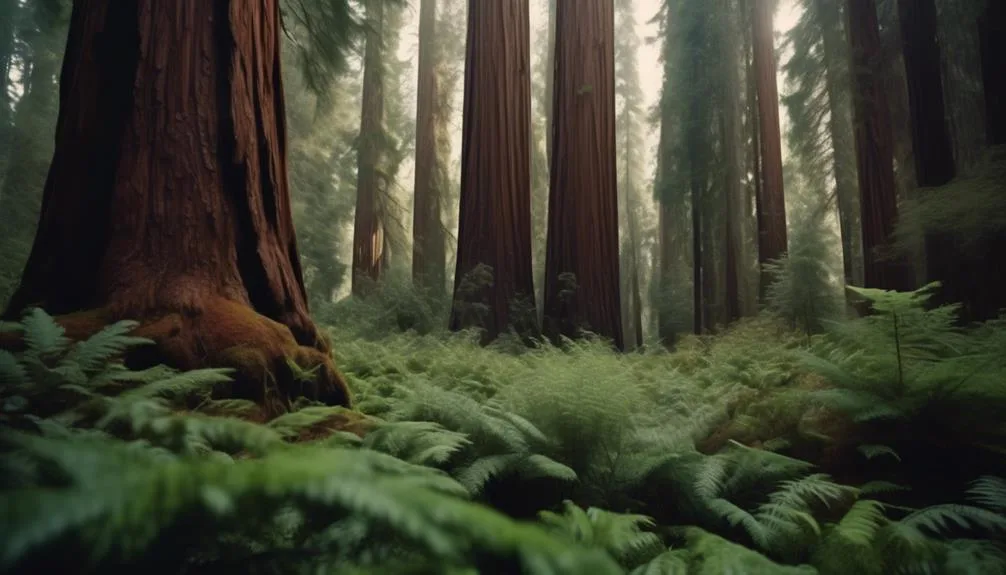Have you ever wondered if redwood trees can grow well alongside other species? It's an interesting question.
Redwoods are famous for their size and strength, but how they interact with other plants is a complex topic. Whether it's competition for resources, the way their roots spread, or the unique environment they create, understanding how redwoods coexist with other species reveals the intricate workings of forest ecosystems.
Redwood Trees and Other Species Compatibility
When planting redwood trees, it's important to consider the compatibility with other species in the surrounding environment. Redwood trees have a significant ecological impact, promoting biodiversity conservation by providing habitats for various species.
However, their dense tree canopy can lead to sunlight competition, affecting the growth of other plants. To mitigate this, it's crucial to choose companion species that can thrive in the shade and coexist with redwoods. This careful selection not only ensures the health and diversity of the ecosystem but also contributes to the overall sustainability of the area.
Factors Affecting Redwood Tree Growth Alongside Other Species
To ensure successful growth alongside other species, consider the factors that can impact the development of redwood trees in their ecosystem. Biodiversity benefits redwood trees by providing them with a more stable and resilient environment. When redwoods grow alongside a variety of other species, it promotes a healthier ecosystem, as different species contribute to nutrient cycling, pest control, and overall ecosystem productivity.
However, competitive interactions with other species can affect redwood tree growth. Some species may compete for resources such as sunlight, water, and nutrients, potentially impacting the growth and health of redwood trees. It's essential to understand these competitive interactions and manage them effectively to support the growth of redwood trees alongside other species.
Successful Combinations of Redwood Trees and Other Species
Curious about which species thrive alongside redwood trees? Redwoods create unique ecosystems that support a variety of plant and animal species. When it comes to successful combinations, consider the following:
- Plant Companions: Redwoods thrive alongside species such as western sword fern and huckleberry, which not only complement their beauty but also contribute to soil health and moisture retention. These plant companions offer ecological benefits by creating a balanced microclimate and promoting biodiversity within the redwood forest ecosystem.
- Animal Companions: Certain bird species, like the marbled murrelet, and mammals, like the northern spotted owl, find ideal habitats within redwood forests, contributing to the overall biodiversity promotion and ecological benefits of the ecosystem.
These successful combinations provide ecological benefits and promote biodiversity, contributing to the overall health and resilience of redwood forest ecosystems.
Challenges of Growing Redwood Trees Next to Other Species
Growing redwood trees next to other species presents several challenges, including competition for resources and differences in preferred environmental conditions. When redwood trees are planted alongside other species, they engage in root competition, where the trees compete for water, nutrients, and space. This can hinder the growth of both the redwoods and the neighboring species. Additionally, canopy interaction can lead to shading issues, affecting the sunlight exposure for all species involved. These challenges can have ecological impacts on the surrounding environment, potentially impacting biodiversity maintenance. To illustrate the challenges of growing redwood trees next to other species, consider the following table:
| Challenges | Description | Impact |
|---|---|---|
| Root competition | Competing for water, nutrients, and space | Hinders growth |
| Canopy interaction | Shading issues, affecting sunlight exposure | Ecological impacts |
Understanding and addressing these challenges is crucial for successful coexistence of redwood trees and other species.
Best Practices for Planting Redwood Trees Alongside Other Species
When planting redwood trees alongside other species, it's essential to carefully consider the specific needs and characteristics of each species to ensure successful coexistence. Here are some best practices to keep in mind:
- Tree Spacing and Biodiversity
Ensure adequate spacing between redwood trees and other species to prevent competition for resources like sunlight, water, and nutrients.
Select companion species that complement the redwood's habitat and contribute to overall ecosystem diversity.
- Soil Interactions and Mutual Benefits
Consider the soil preferences and interactions of different species to promote symbiotic relationships and mutual benefits.
Utilize nitrogen-fixing plants near redwoods to enhance soil fertility and support the growth of these majestic trees.
Conclusion
Consider the soil type, sunlight, and water availability when planting redwood trees alongside other species. Successful combinations include ferns, rhododendrons, and azaleas, but competition for resources and potential damage from neighboring plants can pose challenges.
To ensure successful growth, provide enough space and proper care for all plants involved.
How can we create harmonious ecosystems that benefit all species?
Happy planting!
Mark Hoffman is a dedicated arborist and tree care specialist with over a decade of experience. His love for trees began when he visited Yosemite National Park as a teenager and was awestruck by the giant sequoias. Mark pursued his passion by studying forestry at Michigan Technological University, where he earned a Bachelor of Science degree.
Since then, he has worked tirelessly in the field of arboriculture, helping to preserve and protect trees in his community. His expertise and dedication have made him a respected leader in the industry and a valuable resource for anyone seeking advice on tree care.
